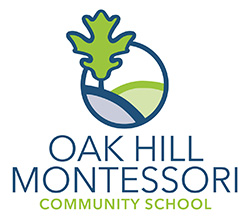Children’s House (Kindergarten)
5 or 6 years

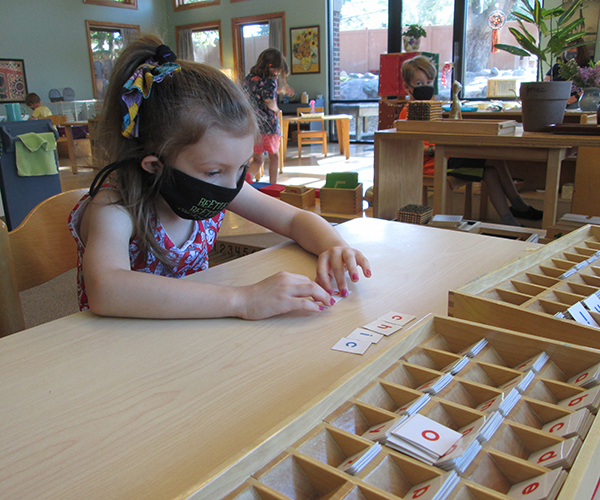
Level Overview
During the final stage of the multi-year cycle, Kindergarten students act as the classroom leaders in the combined classroom with children as young as three. At first glance, a Children’s House classroom can appear to an outsider as an unstructured environment with beehive-esque energy and activity. But when looked at more closely, that beehive is being driven by students doing their own work, after making their own choices. Some children may be working alone, others in pairs or groups. The classroom is designed to allow students to learn in the manner which best suits them.
Purpose and Goal
Dr. Montessori felt that the goal of early childhood education should not be to fill the child with facts from a pre-selected course of studies, but rather to cultivate the child’s own natural desire to learn, developing his/her own intellect and personality.
Classroom Structure
The Children’s House structure provides benefits to both the younger and older students alike. When the Kindergartener can help guide a younger classmate through his/her work, the younger student benefits from the social and educational interaction, while the older student reinforces his/her academic skill set and develops leadership skills. In this level, learning self-direction and self-worth is as important as academics.
Every bit of learning in the Children’s House room is essentially a puzzle. This objective is approached in two ways: first, by allowing each child to experience the excitement of learning by his/her own choice rather than by being led; and second, by helping the child perfect his/her natural tools for learning.
All students in this level benefit from group activities. From discussions and recess to stories and songs, being together is an integral part of the day in Children’s House.
Targeted Outcomes for students after completing the Kindergarten year of the Children’s House program
- Independent care of self
- Foundational knowledge of all four mathematical operations
- Phonetic understanding of reading and writing
- Understanding the basics of sentence structure
- Strong sense of who they are as people
- Consideration for fellow students and adults
Elementary
Lower Elementary: First – Third Grade
Upper Elementary: Fourth – Sixth Grade
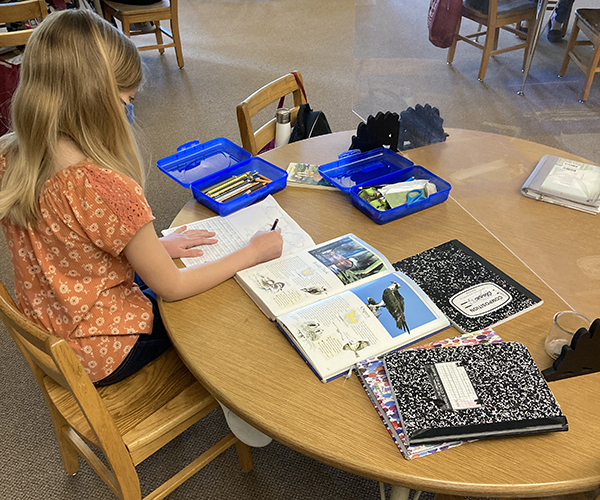
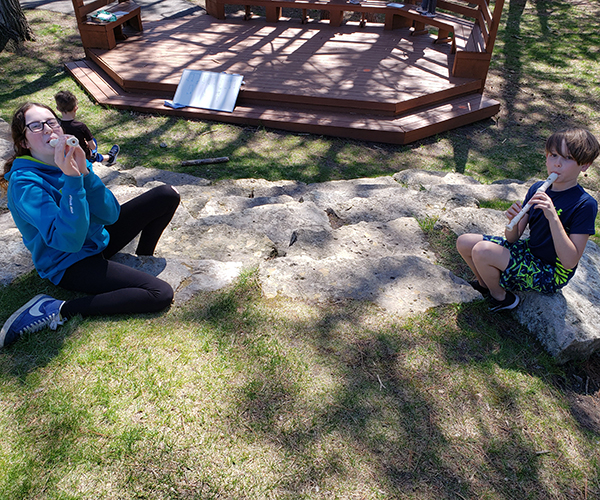
Level Overview
Children in the elementary years have an intellectual power unsurpassed at any other age as they become more aware of their potential. They bring to their work two important tools: a powerful reasoning mind and a robust imagination. Students are deeply immersed into the process of researching, classifying and ordering; examining everything from history and botany to language and mathematics.
Purpose and Goal
Elementary students are natural explorers in the world around them. These intellectual tools combined with a natural urge to collaborate opens a field of exploration so vast that virtually any concept or system can be explored. Using both hands-on materials, and tapping into the brain’s developing abstract thinking, the elementary classrooms are designed to advance both academic reasoning and social knowledge.
Classroom Structure
The elementary years are divided into Lower (first – third) and Upper (fourth – sixth) classrooms. Montessori curriculum integrates subject areas to highlight inter-related areas of study creating awareness and curiosity which makes learning even more exciting and challenging. Teachers utilize stories, presentations and charts to enrich and enhance his/her interest in learning.
The elementary years take the next steps in developing a well-rounded person; the outside world becomes a crucial part of the learning process. “Going Out” activities happen frequently to allow students the opportunity to explore what they are learning hands-on. Whether it is a trip to the museum, shopping for food at an ethnic grocer or attending a performance, being out of the classroom enhances the research happening inside of it. Studies in Spanish continue with designed intensity into the weekly schedule as well. Additional materials are available in each classroom if students choose to advance their grasp of this wonderful language.
From utilizing the art studio to make pieces which support their studies, to performing in a play, or becoming more versed in their musical talents, elementary students at Oak Hill are enriching their entire being with deeper exposure to art, music and theatre.
Targeted outcomes at the completion of each Elementary level
Lower Elementary
- Mastery of 2, 3 & 4 digit math problems using all operations
- Writing with proper sentence & paragraph structure while minimizing spelling errors
- Knowledge of Continents & Oceans, as well as the Solar System & Universe
- Experience researching animal/plant kingdoms as well as basic understanding of scientific method
- Exposure to basic mathematical operations of fractions & decimals
- Study of cultures, civilizations and History timelines
- Able to identify and explain parts of speech
Upper Elementary
- Mastery of whole numbers, integers, fractions & decimals using all operations
- Exposure to World, United States & Minnesota history
- Comfort in presenting research findings both verbally and written
- Early exposure to algebraic equations and geometry
- Able to read and evaluate fiction and nonfiction materials
- Well versed in the scientific method as well as the topics of Biology, Earth Science, Chemistry and Physics
- Knowledge of homonyms, synonyms & antonyms through word study
Junior High
7th & 8th Grade
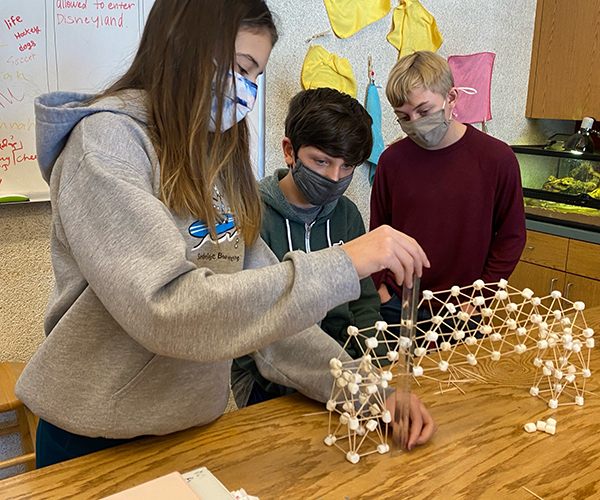
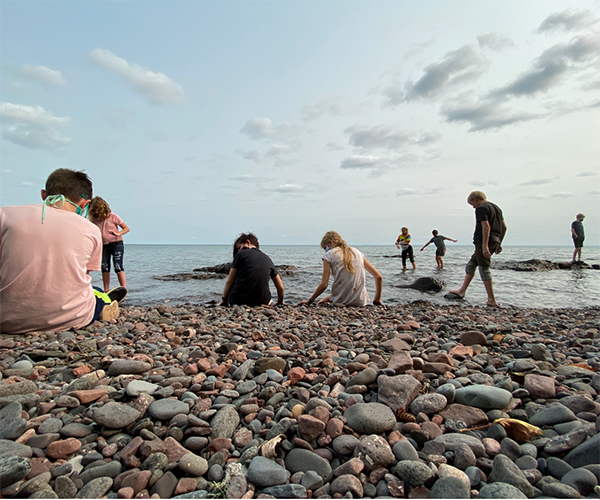
Level Overview
As the culmination of the Oak Hill experience, the Junior High program introduces new styles of learning to students which many have not experienced in prior Montessori classrooms. The classroom is team-taught, and the curriculum is experiential and interdisciplinary, all the while being student-centered. Learning out of textbooks is balanced by learning through the hands and the body. Junior High is where the lessons truly delve more into the abstract, all the while granting students the freedom to utilize materials from memory or the imagination to support and enhance the learning experience. Our Junior High program positions our students for success in the next steps in her/his educational journey.
Purpose and Goal
The seventh and eighth grade years are critical for both the intellectual and emotional development of young women and men. The intentional structure of the students being in the same classroom with the same teachers all day creates mutual trust and a collegial nature which is rarely found during this age range. Every day in the Junior High challenges the head, hands and heart to help each student reach his/her highest potential.
Classroom Structure
To an outside eye, Junior High looks a lot more like “traditional school” than the rest of the classrooms at Oak Hill. Textbooks are utilized to support pedagogy, and the students have a larger quantity of assignments to turn in as homework than any other level; however, the freedom of work choice is seamlessly integrated into the curriculum as well. Junior High students encounter math seminars, humanities simulations and opportunities to express themselves through spoken word performances and film festivals. Art and Music are delivered at a level where students graduating our programs will be prepared to continue their artistic endeavors if they choose to do so.
Alumni often reference back to the freedom they experienced in Junior High as one of the most influential elements of their successful transfer into the High School level. Getting out of the classroom for day trips and long outings is a crucial portion of the Junior High experience as it builds leadership skills and strengthens the bonds of the community. Whether it is a trip to the science museum or going to Washington D.C., Oak Hill strongly believes that learning happens outside the classroom as much as it does in it.
Targeted Outcomes for students after completing the Junior High program
- Comfort with constructive feedback leading new levels of creative, independent and critical thinking
- Familiarity with the concepts of Algebra and Geometry streamlining the transition to High School mathematics
- Personal knowledge of current events, government and civics leading to engaged and informed citizens
- Excellent communication skills in the areas of writing, speaking and listening
- Hands-on experience taking problems through the scientific method/using scientific experimentation
- An understanding of the interconnected nature academic subjects share
- Extensive skillsets in collaborative problem solving and group work dynamics
- Refined time management, prioritization and research skills
OHMCS has adopted and implemented an Upper School Literacy Plan to assess and appropriately support all learners in achieving intended outcomes.
